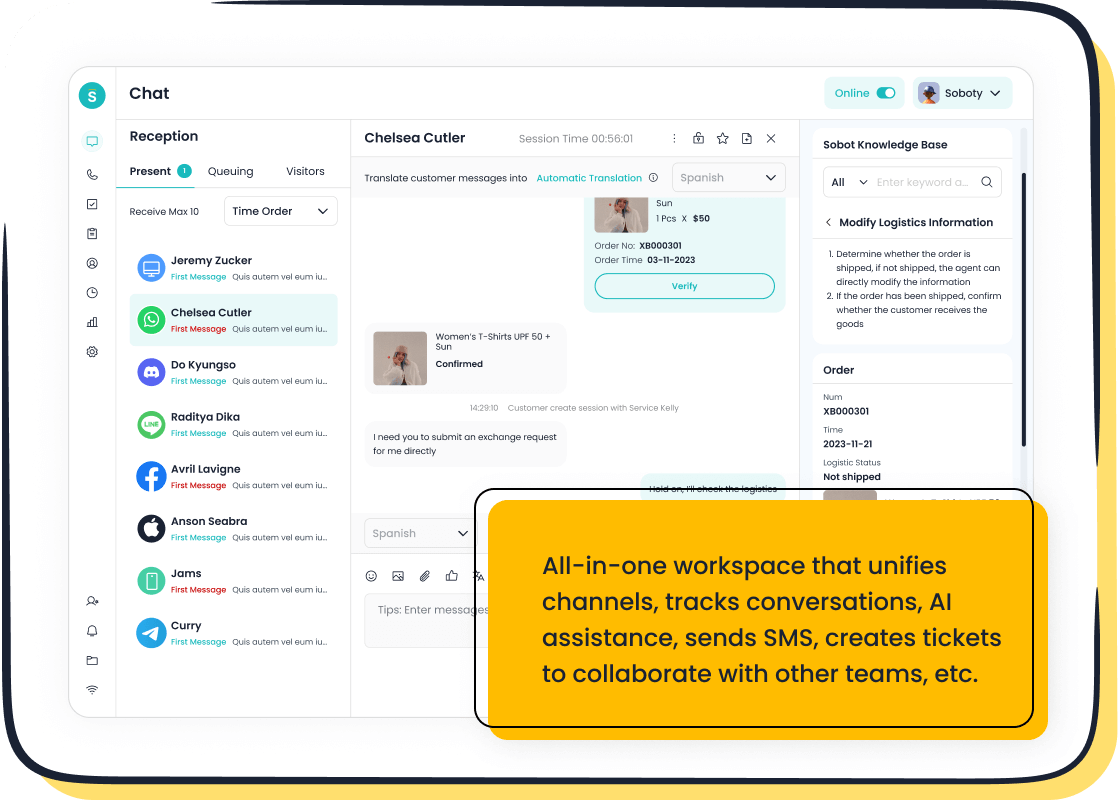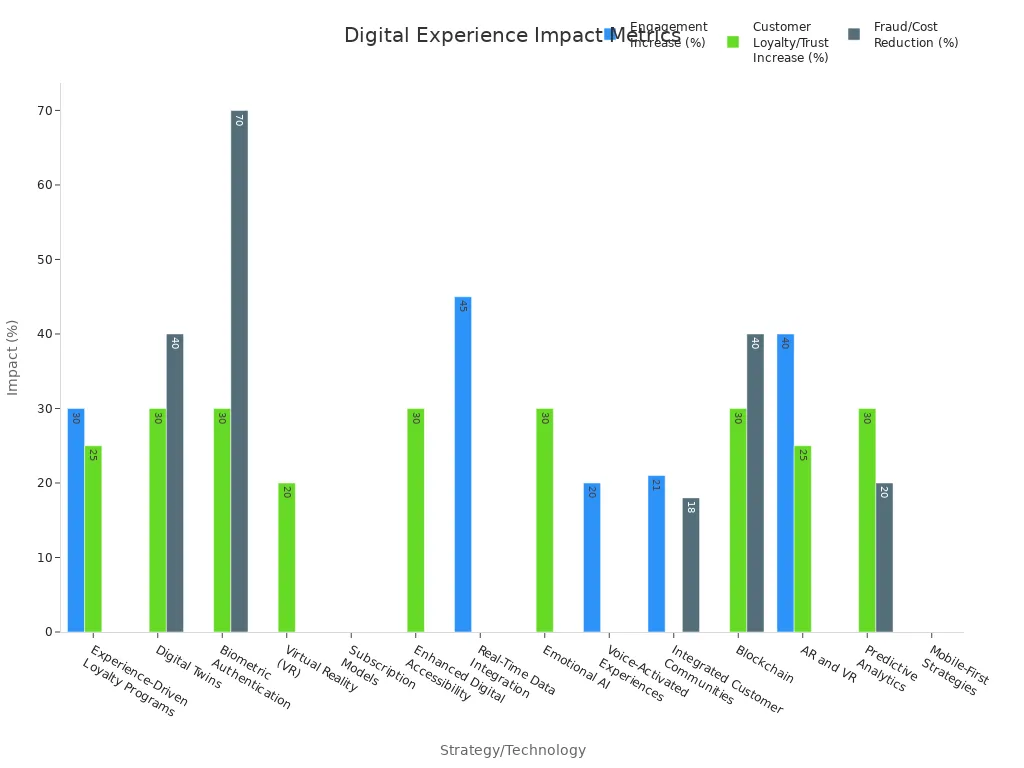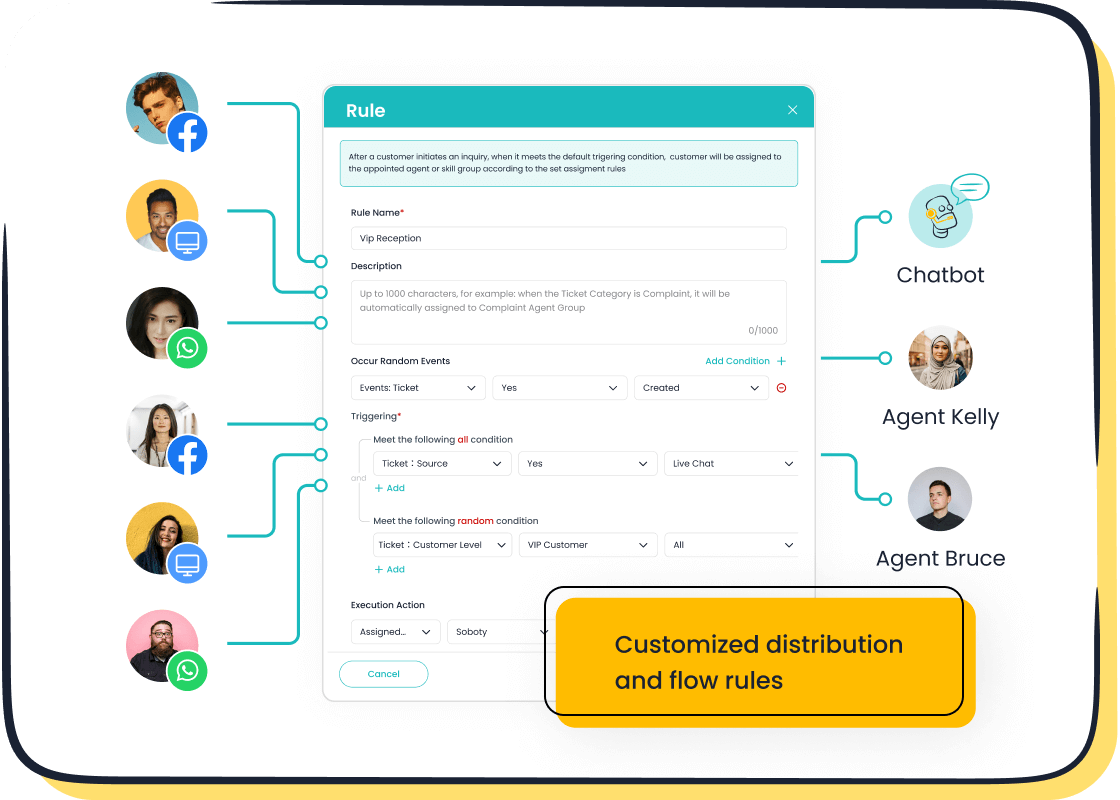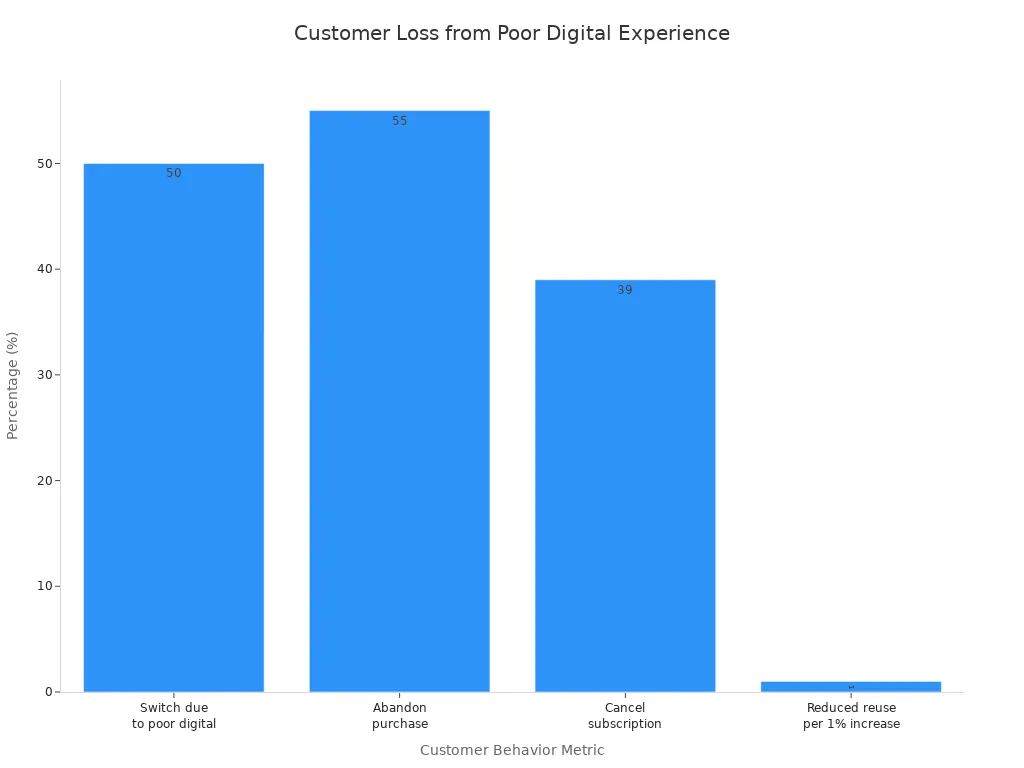Why Every Business Needs a Digital Experience Strategy Today

Every business today needs a digital experience strategy to remain competitive. Digital interactions shape the way customers perceive value and trust. Industry reports show that a strong customer experience boosts loyalty and drives growth by improving retention and satisfaction. A positive digital experience encourages repeat business and referrals, as 43% of consumers pay more for convenience and friendly service. Solutions like Sobot and Sobot AI transform customer interactions with seamless, personalized support across every channel.

Digital Experience Strategy

Definition and Core Elements
A digital experience strategy gives businesses a clear plan to improve every digital customer interaction. Leading experts agree that a strong digital customer experience strategy includes three main components:
- Vision: Companies assess their current digital state, set clear goals, and create a plan for meaningful change.
- Strategy: Teams define actionable steps, set objectives, anticipate challenges, and develop solutions.
- Roadmap: Leaders prioritize projects, track progress, and choose the best methods for implementation, such as agile or design thinking.
A digital customer experience strategy also requires ongoing reporting, change management, and measurement of both quantitative and qualitative results. Businesses track revenue growth, cost savings, and customer satisfaction. They also monitor employee engagement and innovation. Continuous improvement and stakeholder engagement keep the strategy aligned with business goals.
A well-structured digital experience strategy helps companies deliver consistent, high-quality customer experiences across all digital channels. This approach builds trust and loyalty, which are essential for long-term success.
Sobot’s Approach
Sobot’s mission centers on creating an experience-led, easy-to-use, and efficient AI platform. This aligns closely with the core elements of a digital customer experience strategy. Sobot’s Five-AI system covers Omnichannel AI, Scenario-based AI, Multi-faceted AI, Generative AI, and Secure AI. These technologies ensure seamless, personalized, and intelligent customer interactions across chat, voice, email, and social media.
- Omnichannel AI connects websites, apps, and social platforms, providing a unified digital experience for every customer.
- Scenario-based AI addresses industry-specific needs, especially in retail and e-commerce, supporting the entire customer journey.
- Multi-faceted AI supports customers, agents, and administrators, improving service quality and operational efficiency.
- Generative AI uses advanced models to deliver accurate, professional responses, supporting personalization and automation.
- Secure AI maintains compliance with global data privacy standards, which is vital for any digital customer experience strategy.
Sobot’s product suite, including Live Chat, AI Agent, and Chatbot, enables businesses to deliver intelligent, scalable, and human-like customer experiences. Sobot’s continuous innovation and focus on efficiency help companies achieve their digital customer experience strategy goals.
Customer Loyalty Benefits

Seamless Omnichannel Service
A digital customer experience strategy creates seamless service across all channels. Customers expect to move between websites, apps, and stores without losing context. When companies deliver this, they build trust and loyalty. Research shows that 73% of shoppers use multiple channels during their journey. Omnichannel customers spend more and return more often than single-channel shoppers.
| Evidence Aspect | Key Findings |
|---|---|
| Spending Behavior | Omnichannel customers spend 4% more per in-store visit and 10% more online. |
| Repeat Visits | They log 23% more repeat shopping trips within six months. |
| Recommendation Likelihood | More likely to recommend the brand to family and friends. |
| Customer Retention Impact | A 5% increase in retention can boost profits by 25% to 95%. |
| Loyalty Program Influence | 77% in good loyalty programs stay; 70% recommend the brand. |
| Customer Spending | Loyal customers spend 31% more than new customers. |
| Technology Role | AI and cloud enable seamless, personalized omnichannel experiences. |
| Omnichannel Usage | 73% of shoppers use multiple channels, increasing their value to retailers. |
Customers value features like instant support, preserved conversation history, and the ability to switch channels without repeating themselves. Companies that integrate customer data across all touchpoints can personalize every interaction. This approach reduces frustration and increases satisfaction. Academic studies confirm that seamless omnichannel experiences drive long-term loyalty and repeat business. Disconnected experiences cause 60% of customers to switch brands, showing the importance of a unified digital approach.
Companies that use omnichannel support see higher engagement, more repeat visits, and stronger customer relationships.
Personalization and Engagement
Personalization stands at the heart of a successful digital customer experience strategy. When companies tailor messages, offers, and support to individual needs, customers feel valued. Personalized experiences increase engagement and encourage repeat purchases. For example, a major South Asian bank used personalized rewards and regional language ads, reducing acquisition costs by 68% and boosting brand awareness by 58%.
According to a 2023 Medallia survey, 82% of consumers say personalized experiences influence their brand choice in at least half of shopping situations. Companies that focus on personalization are twice as likely to improve customer experience and 26 times more likely to see over 20% annual revenue growth. Personalized recommendations and offers also increase customer satisfaction and emotional loyalty, making customers less likely to switch to competitors.
Personalization helps companies build meaningful relationships with their customers. It addresses individual preferences, reduces churn, and increases advocacy. Customers who receive personalized service are more likely to return, spend more, and share positive feedback.
Sobot Live Chat for Loyalty

Sobot Live Chat plays a key role in enhancing customer loyalty. The platform supports omnichannel communication, allowing customers to connect through websites, apps, and social media. Sobot’s AI-powered tools help agents respond quickly and keep conversations consistent across all channels. This reduces customer effort and increases satisfaction.
- Sobot’s AI chatbots lower customer effort by 25% and boost satisfaction by 10%.
- Clients report a 25% drop in complaints and a 20% rise in satisfaction using predictive analytics.
- Proactive communication through Sobot reduces churn rates by 25% and increases upsell opportunities by 15%.
- Companies like Samsung achieved a 97% customer satisfaction score with Sobot’s all-in-one solution.
| Company | Customer Loyalty Metrics Impacted | Key Outcomes with Sobot Live Chat and AI Solutions |
|---|---|---|
| Michael Kors | Customer service and marketing effectiveness | Improved customer contact and engagement |
| Samsung | Customer Satisfaction (CSAT) | Achieved 97% CSAT with Sobot’s all-in-one solution |
| Agilent | Customer service efficiency | 6x increase in service efficiency |
| Opay | Customer Satisfaction (CSAT) | 90% customer satisfaction with Sobot’s solution |
Sobot Live Chat unifies all customer interactions, making it easy for agents to deliver personalized, timely support. The platform’s analytics and AI-driven insights help companies measure and improve customer experience, leading to higher loyalty and stronger relationships.
Business Growth Impact
Revenue and Retention
A digital customer experience strategy drives business growth by increasing both revenue and retention. Companies that focus on customer experience see strong results. For example:
- Companies treating customer service as a value center achieve 3.5 times more revenue growth.
- Improving customer experience leads to a 42% increase in retention and a 33% boost in satisfaction.
- 61% of consumers will pay at least 5% more for a good customer experience.
- Brands with strong omnichannel engagement strategies see 10% year-over-year revenue growth and a 25% increase in close rates.
These numbers show that investing in digital customer experience strategy pays off. Customer-centric brands report profits 60% higher than those that do not focus on experience. When companies improve customer retention, they also increase revenue growth and create a loyal customer base. In today’s market, 80% of organizations expect to compete mainly on customer experience, and 73% of customers consider it the top factor when making a purchase decision (source).
A strong digital customer experience strategy is not just about satisfaction. It is about driving revenue and building long-term business success.
Operational Efficiency
Digital strategies help businesses work smarter and faster. Automation of routine tasks reduces operational costs and saves time. Data analytics enable informed decision-making, while streamlined workflows improve productivity and service quality. Companies that adopt digital tools see fewer errors, faster task completion, and better resource allocation.
- Automation of routine tasks saves time and reduces errors.
- Streamlined workflows enable faster task completion.
- Improved access to data supports better decision-making.
- Enhanced employee productivity and satisfaction.
- Cost savings through more efficient processes.
- Real-time updates improve task delegation and reduce communication delays.
A well-executed digital customer experience strategy boosts operational efficiency. Businesses lower overhead costs and reduce the total cost of technology ownership. These improvements help companies respond quickly to customer needs and stay ahead in a competitive market.
Sobot in Ecommerce & Retail
Sobot’s ecommerce and retail solution shows how digital customer experience strategy leads to business growth. Sobot’s AI platform integrates websites, apps, social media, and messaging channels. This creates seamless, omnichannel experiences for every customer. The platform answers pre-sales questions 24/7, offers personalized recommendations, and resolves post-sales issues quickly.
OPPO, a global smart device brand, used Sobot’s AI-powered live chat and data analysis tools to transform its customer experience. The results speak for themselves:
| Business Outcome Metric | Result Achieved by OPPO Using Sobot AI Solutions |
|---|---|
| Positive Customer Experience Rate | 90% |
| Customer Churn Reduction | 25% |
| Increase in Repurchase Rate | 57% |
| Conversion Rate Increase | 38% |
Sobot’s solution enabled OPPO to deliver hyper-personalized, omnichannel experiences and predictive analytics. The AI data analysis tool helped OPPO profile customers and run targeted marketing campaigns. These improvements led to higher conversion rates, increased retention, and stronger business outcomes.
Sobot’s digital customer experience strategy supports business success by driving revenue, improving retention, and creating lasting customer relationships.
Risks Without a Strategy
Losing Customers
Companies without an effective digital customer experience strategy face a high risk of losing customers to competitors. Research shows that 50% of consumers switch to another company after a poor digital experience. More than half abandon their purchase, and 39% cancel subscriptions when digital interactions disappoint. Even a single negative experience can drive one in three customers away from a brand they once loved. Most dissatisfied customers do not complain; they simply leave and share their disappointment with others.

Companies that lack a unified approach often deliver inconsistent service, leading to silent churn and missed opportunities for feedback.
Negative Brand Perception
Poor digital experiences quickly damage brand reputation. Customers judge trustworthiness based on the quality of digital interactions. Slow support, confusing navigation, or unfriendly representatives frustrate users and reduce engagement. Negative feedback spreads fast on social media, making it hard for brands to recover. Studies reveal that 32% of customers stop doing business with a brand after just one bad experience. In some regions, this number rises to nearly half. Common issues like hidden fees, slow websites, or inconsistent brand voice all contribute to a negative image.
A single digital misstep can erode years of brand loyalty and trust.
Missed Opportunities
Businesses without a digital strategy often miss key growth opportunities. Famous brands like Sears and Blockbuster failed to adapt to digital trends and lost market share. Companies that do not align digital efforts across departments end up with fragmented projects and wasted resources. Resistance to change and outdated systems slow down transformation. Without clear metrics, leaders struggle to measure progress and build confidence.
| Category | Evidence Summary |
|---|---|
| Characteristics of Incomplete Strategies | Lack of customer focus, siloed initiatives, inadequate resources, neglect of security and compliance, short-term focus, technology-centric approach |
| Warning Signs | Inconsistent customer experience, disconnected digital touchpoints |
| Impact on Business Functions | Marketing: ineffective campaigns, poor personalization; Sales: missed digital sales, poor integration; Customer Service: fragmented support, lack of omnichannel capabilities |
| Short-term Risks | Wasted resources, frustrated customers and employees, security vulnerabilities, compliance issues |
| Long-term Risks | Loss of market share, erosion of brand loyalty, difficulty attracting talent, increased technical debt, reduced profitability, potential business failure |
Sobot helps businesses avoid these risks by providing integrated, omnichannel solutions that keep the customer at the center of every interaction. Companies that invest in digital experience platforms like Sobot position themselves for long-term success and resilience.
Building a Successful Digital CX Strategy
Assessing Touchpoints
A successful digital cx strategy starts with a clear understanding of every customer interaction. Businesses should step into the customer's shoes and experience the buying process firsthand. They need to identify all digital touchpoints, such as websites, social media, email, and support channels. Using analytics and customer feedback, companies can analyze pain points, like high bounce rates or low conversion rates. Optimizing these touchpoints improves usability and engagement. Automation tools help streamline repetitive tasks, while continuous monitoring ensures the strategy adapts to changing needs. Companies like IBM use data analytics to map and improve digital interactions across channels, leading to higher satisfaction and loyalty.
Leveraging Sobot Live Chat
Sobot Live Chat enhances digital customer experience by integrating AI-powered tools that streamline workflows and reduce manual errors. The platform uses real-time analytics to monitor interactions, identify bottlenecks, and optimize processes. Sobot’s AI agents provide 24/7 support, automate repetitive tasks, and deliver personalized experiences based on customer data. Clients have seen up to a 400% increase in productivity and significant improvements in satisfaction. Sobot’s seamless integration across channels ensures consistency and allows human agents to focus on complex issues, driving better outcomes for both businesses and customers.
Consistency Across Channels
Consistency is vital for building trust and loyalty in digital customer experience. Companies should establish a unified brand identity, including logos, colors, and messaging, across all channels. Detailed customer segmentation helps tailor content and interactions. An omnichannel content strategy ensures seamless integration and synchronization of data and user experience. Businesses must standardize the quality of experience at every touchpoint and use integrated support systems to share customer data. Continuous testing and feedback loops help maintain consistency and adapt to evolving expectations.
Measuring Success
Measuring the success of a digital cx strategy requires tracking key performance indicators (KPIs). The table below outlines essential KPIs:
| KPI Category | Key Metrics | Description/How to Measure |
|---|---|---|
| Customer Acquisition | CAC, CLV, Conversion Rates, Direct Traffic | Track costs, value, and conversion effectiveness |
| Customer Engagement | CSAT, CES, Avg. Resolution Time, Pages per Visit | Survey scores, speed, and depth of engagement |
| Customer Retention | Retention Rate, NPS, Churn Rate | Loyalty, advocacy, and loss rates |
Businesses should use real-time dashboards and predictive analytics to gain insights and drive continuous improvement. Regularly collecting and acting on customer feedback ensures the strategy remains effective and aligned with business goals.
Business leaders now see digital experience as essential for growth, customer loyalty, and staying ahead. Recent studies show 75% of executives rank digital experience as a top priority, linking it to revenue and brand strength. Key reasons to act include staying competitive, driving innovation, and improving customer engagement. Companies use tools like Sobot to automate support, boost satisfaction, and cut costs. To succeed, every business should review its digital strategy and take steps to deliver seamless, data-driven experiences.
Ready to transform your business? Start by exploring solutions that put digital experience first.
FAQ
What is a digital experience strategy?
A digital experience strategy is a plan that helps businesses improve every online interaction with customers. Companies use this strategy to boost loyalty, increase sales, and stay competitive. Sobot’s solutions help brands deliver seamless digital experiences across all channels.
How does Sobot Live Chat support a digital experience strategy?
Sobot Live Chat unifies messages from websites, apps, and social media. Agents use AI tools to respond quickly and personalize service. This approach increases conversion rates by 38% and improves customer satisfaction. Learn more at Sobot Live Chat.
Why is omnichannel support important for customer loyalty?
Omnichannel support lets customers switch between channels without losing context. Research shows 73% of shoppers use multiple channels (source). Sobot’s digital experience strategy ensures consistent service, which builds trust and loyalty.
What results can businesses expect from using Sobot’s digital experience strategy?
Businesses using Sobot’s digital experience strategy see higher retention, better satisfaction, and increased revenue. For example, OPPO achieved a 57% increase in repurchase rate and a 94% positive feedback rate after using Sobot’s AI-powered solutions.
How can companies measure the success of their digital experience strategy?
Companies track key metrics like customer satisfaction (CSAT), Net Promoter Score (NPS), and conversion rates. Sobot’s analytics dashboard provides real-time data, helping leaders make informed decisions and improve their digital experience strategy over time.
See Also
How To Successfully Deploy Omnichannel Contact Center Systems
Explore Twelve Best Live Chat Tools For Shopify Growth
Best Contact Center Platforms Evaluated For The Year 2024
Comprehensive Guide To Omnichannel Software For Call Centers
